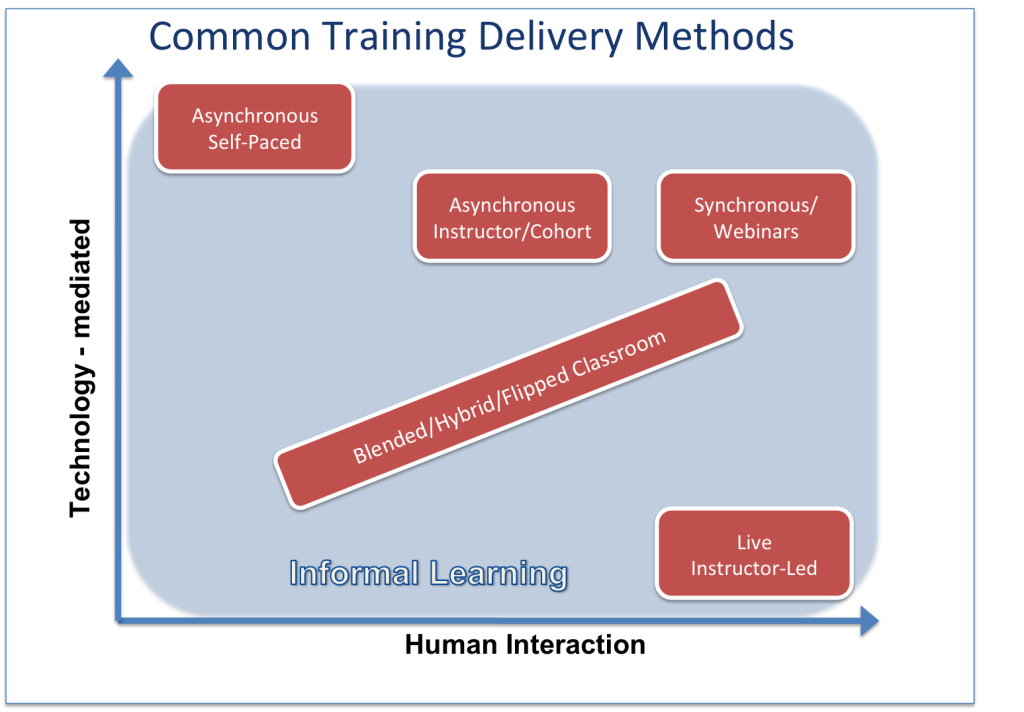Lesson 5 Instructional Environments and Multimedia
5-1 Instructional Environments
Good e-learning environments come in many shapes, depending on what is to be learned and why:
- different platform for delivery
- different instructional approaches
- different use of media
Your challenge is to understand the implications of a given set of learning objectives and to design the appropriate learning environment to achieve them.
The graphic below depicts the most common training environments or delivery methods. On the Y-axis we have ‘technology-mediated’. The higher up on that axis an environment is, the more technology-dependent a course is. The X-axis is ‘human interaction’. As we can see, the traditional live instructor-led course is low in technology but high in human interaction. The blue background represents informal learning, which makes up the bulk of our learning experiences. It is in this area that informal discussion tools and social media/networking tools play a role.

How familiar are you with these instructional environments? Think of your definition before reading the details.
Asynchronous Self-Paced Courses
These are stand-alone courses typically used by corporations, organizations, non-profits and government for compliance or certification. Topics are usually short, required, and developed using e-learning software tools like Articulate Storyline or Captivate. The examples we have reviewed in Weeks 3 and 4 typically fall into this category.
Asynchronous Instructor and/or Cohort Courses
This type of environment is more frequently used by educational organizations and non-profits. Content typically is more academic or for certification. An advantage of these types of courses is the 24/7 flexibility of access linked to a more familiar structure that includes an instructor or cohort. These courses typically span multiple weeks and are created in a learning management system like Moodle, Blackboard, Canvas, Coursera, etc. that facilitates the inclusion of additional elements like discussion boards, quizzes and wikis. This class is an example of this type of environment.
Synchronous Environments and Webinars
We see these types of learning environments used by all industries, and they serve a variety of purposes. Synchronous online environments work well when the content is dynamic, budget is limited, and real-time interaction between instructor/student and student/student is favored even when participants are spread around the world. The nice thing about these solutions is that they can be recorded and dropped into an asynchronous course as a curriculum asset. Common tools used are WebEx, Adobe Connect, Live Meeting, and GoToMeeting.
Blended/Hybrid/Flipped Classrooms
These are learning environments where anywhere from 20-80% of the content is accessed online. This approach allows the lecture and/or pre-work and certain activities to be presented online and leave more hands-on or application-based learning for live, in-person sessions. This approach is commonly used in all industries. This model supports individual pacing, minimizes demand for live attendance, and permits differentiated instruction.
Live Instructor-Led Training (ILT)
This type of learning still predominates and will probably never go away. However, since 2001, e-learning has eroded ILTs control of the adult learning space to where it is only used 60% of the time. Blended/Hybrid learning is 10% of the market, and pure e-learning is a little over 30% of the training and learning market space.
Massive Open Online Course (MOOC)
Not listed on our graph above are MOOCs. A MOOC is an online course aimed at unlimited participation and open access via the web. Something to note, though, is that completion rates hover at around 5-10%. Take a quick look at some infographics on MOOCs.
Initially, the impact of MOOCs was primarily felt in the academic world. However, in recent years MOOCs have had an increasing impact on corporate learning. This article on corporate MOOCs provides a good overview.
Download Instructional Environments as PDF
Mixing Modalities
In the spring of 2020, many academic institutions found themselves switching rapidly to technology-mediated environments since in-person instructor-led training was a health risk. Do not confuse emergency remote-learning with any of these instructional environments when you talk about eLearning environments.
Patti Shank wrote a 5-part series starting in April 2020 on the topic of blending self-paced and live tools for eLearning Industry. She includes references if you want to learn more on specific ideas.
Shank, P. (2020). (The right) learning modalities to deliver digital learning. eLearning Industry
- April 3, 2020 Part 1 The digital learning tools used for on demand and live learning
- April 13, 2020 Part 2 The different learning interactions supported by asynchronous and synchronous tools
- May 12, 2020 Part 3 The use and selection of asynchronous elements
- June 8, 2020 Part 4 The benefits and challenges of synchronous elements
- July 24, 2020 Part 5 The blending of digital modalities
